Why Stocks Belong In A Retirement Portfolio?
Key Takeaways:
- Stocks are an important component of a retirement portfolio: Investing in stocks can help achieve long-term growth and provide a source of income during retirement.
- Advantages of investing in stocks for retirement include higher potential returns, diversification benefits, and hedging against inflation. However, factors such as time horizon, risk tolerance, and asset allocation must be considered before investing in stocks.
- Investing in stocks for retirement can be done through individual stocks, mutual funds and ETFs, robo-advisors, and financial advisors. It is important to debunk common myths about investing in stocks, such as they are too risky or complicated, and to regularly monitor and adjust your portfolio.
Are you wondering whether stock investing is the right choice for your retirement portfolio? In this article, you’ll learn why stocks offer an essential part of a balanced retirement plan. Achieve financial security by diversifying your retirement portfolio to include stocks.
Importance of stocks in a retirement portfolio
Many financial advisors recommend including stocks in a retirement portfolio due to their potential for long-term growth and inflation protection. Stocks offer a higher average return than bonds or cash equivalents, although they are subject to market volatility.
For retirees with a longer time horizon, stocks can help their portfolio grow in value to meet future financial needs. Many companies also offer dividends to investors, increasing income streams during retirement. It is important to diversify a portfolio with stocks from various industries and countries to reduce risk.
Additionally, the use of stocks in a retirement portfolio allows investors to hedge against inflation. While inflation can erode the value of fixed-income assets like bonds, stocks offer a relatively higher potential for growth that can keep pace with inflation over time.
According to a study by Vanguard, a portfolio with 70% stocks and 30% bonds had an average annual return of 8.7% from 1926-2018. Stocks can be a critical component of a retirement portfolio for those seeking long-term growth and protection against inflation.
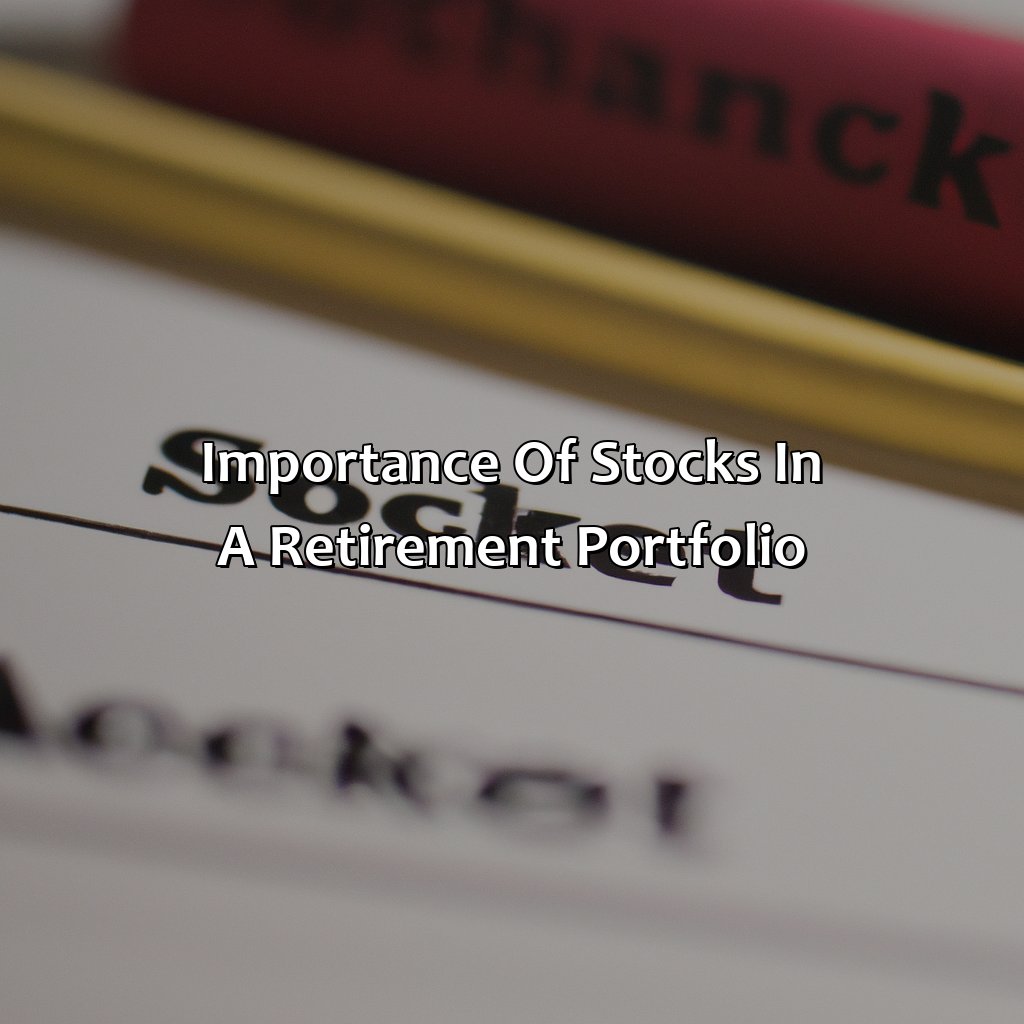
Image credits: retiregenz.com by David Duncun
Advantages of investing in stocks for retirement
Maximize your retirement savings! Investing in stocks has many advantages. These include higher potential returns, diversification benefits, and a hedge against inflation. Make the most of your retirement savings. Explore these sections to create a great strategy:
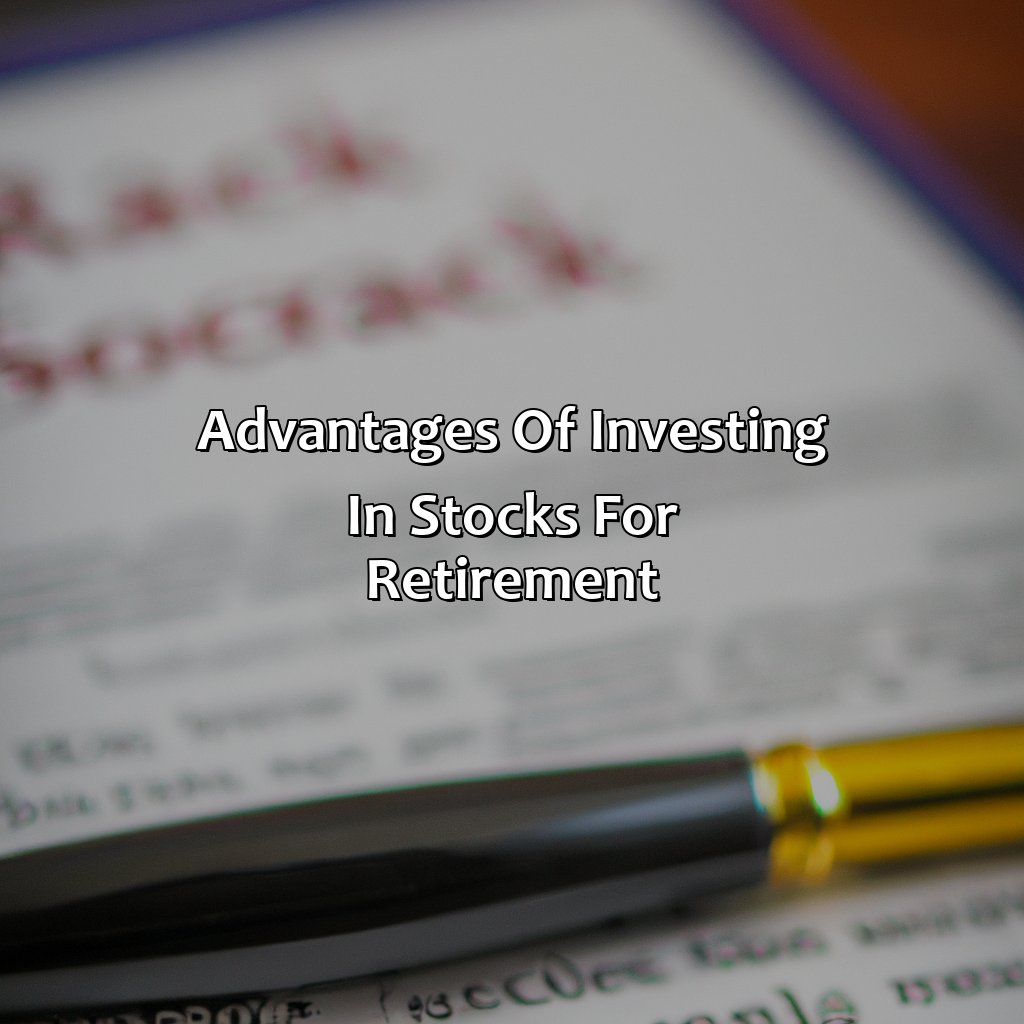
Image credits: retiregenz.com by Joel Washington
Higher potential returns
One reason why stocks belong in a retirement portfolio is the potential for higher returns. Stocks provide the opportunity to generate significant wealth, especially over a long investment horizon. This is because stocks have historically provided higher average returns than other investments, such as bonds and cash equivalents.
Stocks offer ownership in a company’s growth potential, which may lead to larger capital appreciation. Additionally, many companies reinvest profits into their businesses rather than distributing them as dividends, resulting in potentially higher stock prices. While there are risks associated with investing in stocks, such as market volatility and potential losses, these risks can be mitigated through diversification and a well-constructed investment plan.
It’s essential to note that past performance does not guarantee future results. However, history has shown that investing in the stock market over an extended period has yielded higher returns than relying solely on low-yielding fixed-income investments.
If you’re looking to build wealth for retirement and are comfortable taking on some risk, it may be time to consider adding stocks to your portfolio. Don’t miss out on potential gains that could make a substantial difference in your financial future. So start by conducting thorough research or seeking guidance from financial professionals before making any investment decisions.
Diversification is like having a backup plan for your backup plan, just in case your original plan doesn’t plan out.
Diversification benefits
Investing in various stocks offers diversification benefits for retirement portfolios. This involves spreading funds across different stocks and industries, reducing risk exposure to any single investment. By investing in equities with differing performance patterns, the risks from one equity are less likely to impact another.
The diversification benefits of investing in stocks for a retirement portfolio extend beyond reducing market risks such as fluctuations or crashes. Different sectors may perform well under different economic scenarios. For example, technology companies thrive during pandemics while pharmaceuticals benefit during periods of high population growth. As bonds typically have lower returns and higher default risk than equities long term, retirees who depend on investments for income must consider more diverse holdings.
Overseas stock investments can provide unique advantages such as access to emerging markets or specialized industries that may not be available in domestic stock investments. International investments diversify currency risk and geopolitical events influence international economies which do not affect domestic markets.
According to reports, famous investor Peter Lynch’s renounced “buy what you know” strategy helped identify 1,000% gaining companies like Dunkin’ Donuts and Hanes following days exploring stores selling these products. Retirement stock investors can profit tremendously by understanding products they use regularly or services they render and whether it’s a good investment opportunity or not when the time comes to invest in retirement portfolios.
Stocks: the only thing that can fight inflation harder than your grandparents fighting over the last piece of pie at Thanksgiving.
Hedge against inflation
Stocks- a powerful and impressive way to safeguard against the hike in prices. Investing in stock is an excellent way of keeping up with inflation by giving you returns that surpass the general rate of increase in price. Not only do they yield significant dividends, but the shares’ value also increased beautifully over time.
Stocks have always worked wonders as an effective tool to hedge against inflation. Financial experts claim investing in stocks gives a higher return on capital than other traditional financial instruments. Possessing dividend-paying stocks offers an opportunity for investors to receive consistent income that keeps up with the rise in prices.
Stock investment offers a unique advantage over traditional instruments like bonds and Fixed Deposits. The robust returns can allow sustained economic growth and long-term retirement planning for future expenses like healthcare costs.
Investors must assess their tolerance for risk when investing in stocks, which provide market exposure compared to bonds’ predictable annual coupon payments. Over-dependence on low-yield assets can lead to insufficient funds during retirement, so it’s essential to opt for equity investments that provide copious rewards over time.
Take action before it is too late; don’t let the fear of missing out hold you back from making intelligent retirement decisions. Educate yourself about stock trading risk involved and invest your hard-earned money correctly for a fulfilling retirement experience!
Ignore your gut, do some research, and only invest in companies that sell things you understand – like Netflix, vodka, or therapy.
Factors to consider when investing in stocks for retirement
Want stocks for your retirement portfolio? Think about when you’ll invest, how much risk you’re willing to take, and how you’ll divide up your assets. These things will help you reach your financial goals and choose which stocks to go for. In this section, let’s look at each of these factors to make sure you make the best decision for your retirement portfolio.
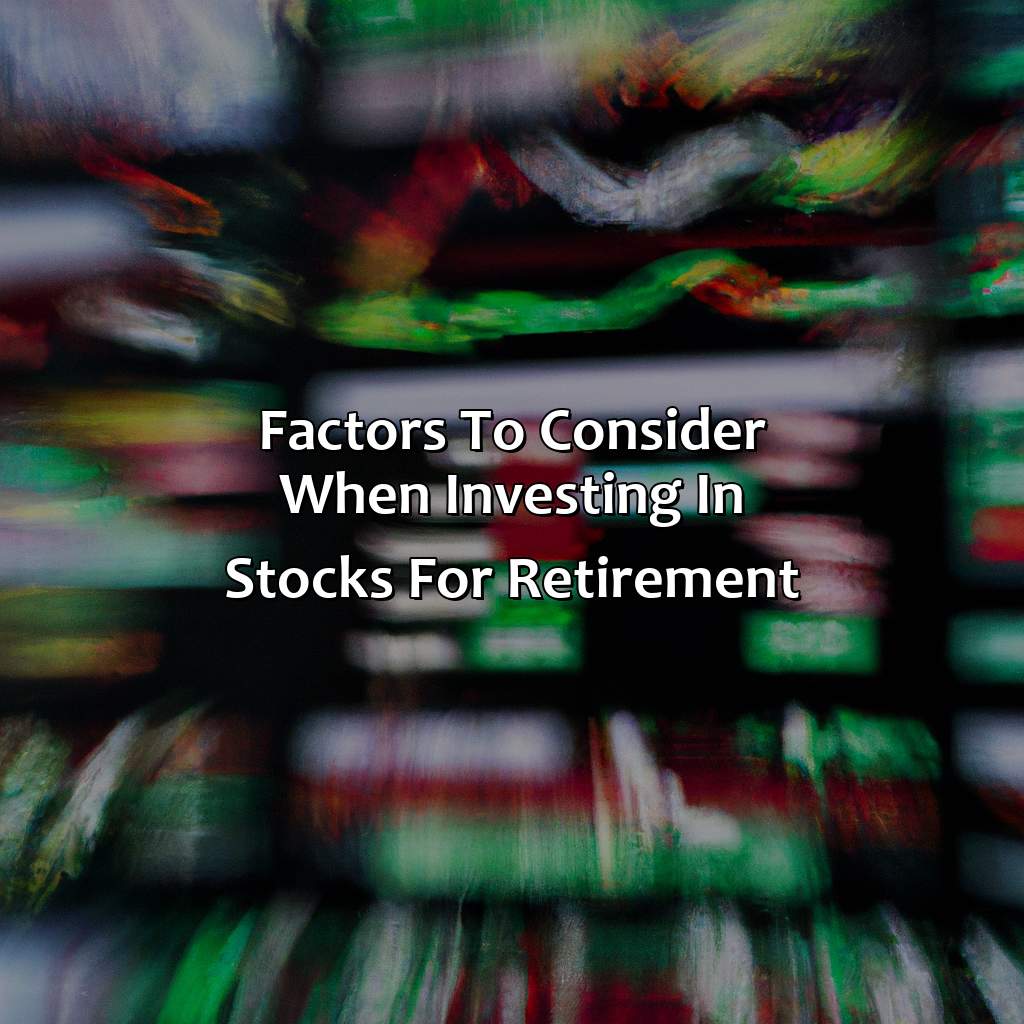
Image credits: retiregenz.com by Adam Woodhock
Time horizon
The length of time one has until retirement, often referred to as the retirement time frame, can greatly impact an investor’s approach to stock investing. Short-term investments may have higher risk, but long-term investments tend to level out and yield a greater return on investment over time. A literal meaning for this heading could be ‘Retirement Time Frame‘.
An extended retirement period allows investors to build a diversified stock portfolio with varying levels of risk depending upon their personal preference. The longer the timeframe, the greater the room for taking calculated risks, making informed decisions and adapting to market fluctuations. Investors should strategize their portfolio according to their goals and individual timelines.
Investors also need to consider any life events that could impact their retirement such as health concerns or job loss. Retirement planning must account for potential future contingencies in addition to anticipated trends.
A seasoned retiree shared how she invested in a well-diversified portfolio of stocks that yielded a hefty amount of gain upon her retirement – allowing her to live comfortably without having any monetary constraints or regrets about not investing enough in her younger years.
Risk tolerance: like spicy food, it’s best to start small and work your way up, unless you want to be sweating at the end.
Risk tolerance
It is vital to analyze and understand your risk capacity before investing in retirement stocks. Assessing the amount of risk you can take on without compromising your financial targets is a significant factor in creating a balanced stock portfolio that provides the returns necessary for retirement.
One of the primary factors that influence risk tolerance is the investor’s age. As people age, they tend to become more risk-averse, preferring low-risk investment options over high-risk ones. This may be due to their inability or unwillingness to recoup losses deemed unacceptable. Younger investors, on the other hand, are typically willing to take on more risks as they have time on their side and can recover from any potential losses.
Furthermore, balancing critical areas such as diversification, value investing and market trends can help control risk levels while offering better odds of long-term success. Investing in stable dividend-paying blue-chip stocks across different sectors can easily hit both goals since these offer stability while ensuring some growth possibilities.
Pro Tip: Carefully assessing your long-term financial objectives significantly influences how much risk you’re willing to take beforehand so you can determine your ideal exposure level.
Remember, asset allocation is like choosing toppings for your pizza – you need a balanced mix to keep things interesting and satisfying.
Asset allocation
When planning for retirement, it’s essential to determine the appropriate asset mix to achieve your long-term goals. Asset allocation refers to the process of diversifying your investment portfolio across different securities to mitigate risk and maximize returns. This can include stocks, bonds, mutual funds, ETFs, and other assets. Proper asset allocation is key to maintaining a stable retirement income.
Investing in stocks for retirement can provide higher returns over time than relatively secure investments like bonds. This approach requires a long-term commitment and a willingness to accept some volatility in the short term. Determining one’s risk tolerance is crucial when deciding how much of their portfolio should be allocated towards stocks.
It’s important not only to consider individual investments but also how they diversify with other holdings in the portfolio. Different assets have varying levels of risk and growth potential that can be enhanced by diversification across various classes.
Pro Tip: Consider working with an experienced financial advisor to help ensure you are making informed decisions about your asset allocation strategy.
Putting your retirement savings in the stock market is like playing a high-stakes game of Jenga, but with money instead of wooden blocks.
How to invest in stocks for retirement
Invest in stocks for retirement. Options include individual stocks, mutual funds, ETFs, robo-advisors, and financial advisors. Investigate the pros and cons of each approach. Make a decision that fits your desired retirement goals.
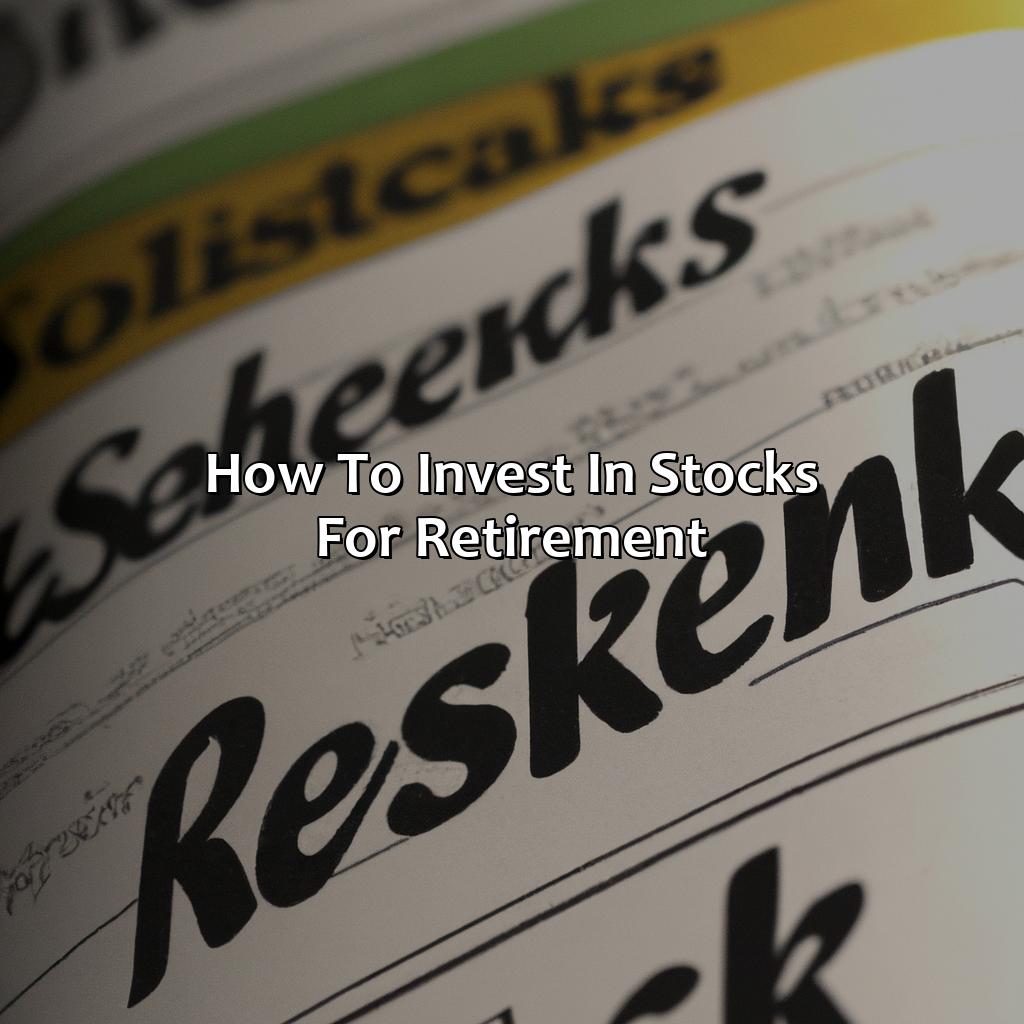
Image credits: retiregenz.com by Adam Arnold
Individual stocks
Investing in individual company stocks is a popular strategy for long-term growth potential. It involves purchasing shares of a particular company and holding those shares over time with the hopes of earning profits based on the company’s performance. This can provide diversification benefits that contribute to the overall composition of a retirement portfolio.
Individual stocks offer investors a unique opportunity to participate directly in the success and growth of specific companies. However, it’s important to understand that investing in individual stocks also carries risk. An investor must perform thorough research on their desired company before purchasing stock to mitigate risks associated with investment.
When investing in individual stocks, be sure to consider diversification strategies as well as any additional fees or taxes associated with buying or selling shares. Incorporating individual stocks into your retirement portfolio can be beneficial when done strategically and with careful consideration.
According to Forbes, over a 30-year period, investments in American common stocks have provided an average annual return of approximately 10%.
If you want someone else to do the heavy lifting of stock picking for your retirement portfolio, mutual funds and ETFs are like having a personal trainer for your finances.
Mutual funds and ETFs
Mutual Funds and ETF Strategies to Consider for Retirement
If you are preparing for retirement, investing in mutual funds and exchange-traded funds (ETFs) is worth considering. Here are some essential takeaways.
- Compared to individual stocks, mutual funds and ETFs offer investors more diversification, reducing risk.
- Mutual funds pool money from many investors to invest in a variety of assets such as stocks, bonds, commodities. ETFs trade on stock exchanges like shares but hold multiple underlying assets with tax efficiency benefits.
- Fund managers run mutual funds while ETFs are passively managed resulting in lower expense ratios.
- Mutual funds work better for buy-and-hold investors looking for professional management.
- ETFs provide flexibility for traders or short-term investors who seek liquidity because they can be bought or sold throughout the trading day.
- Some other features like sector-specific investments can also be accessible such as Technology or Renewable Energy Mutual Funds/Tech ETFs.
Apart from being low-cost investments with less volatility than individual stocks, mutual funds and ETF’s merit cannot be overemphasized. With many options to choose from depending on your financial goals, understanding these investments’ nuances can help build the perfect portfolio without requiring expert knowledge.
To maximize profit potential while minimizing risks during retirement planning, utilizing a combination of mutual fund and ETF strategies based on your unique needs can provide additional stability.
Investing in stocks through these investment vehicles may help boost long-term portfolio returns by providing access to sectors or emerging markets which otherwise would be difficult or expensive using alternative resources. Avoid missing out on potential gains by investigating how leveraging diverse mutual fund/ETF strategies may benefit this critical stage of planning for financial independence.
Robo-advisors are like having a financial advisor who doesn’t judge you for eating ramen noodles every night.
Robo-advisors and financial advisors
Investing in stocks for retirement can be a daunting task, but it’s a necessary one. As you plan your investment strategy, there are two options available to you: robo-advisors and financial advisors. Robo-advisors use algorithms and data to provide investment recommendations, while financial advisors offer personalized advice based on your goals and risk tolerance.
Both options have their pros and cons, and it ultimately comes down to which one fits your investment style best. If you prefer a hands-off approach with low fees, then robo-advisors may be the right choice. However, if you prefer more control over your investments and want a human touch, then a financial advisor may be the better option.
It’s important to remember that investing in stocks is not without risks. However, diversifying your portfolio with stocks can lead to higher returns over the long term. By including stocks in your retirement portfolio, you’re giving yourself a better chance at reaching your financial goals.
Don’t let fear of the unknown hold you back from investing in stocks for retirement. You don’t want to miss out on potential gains by sitting on the sidelines. With the help of robo-advisors or financial advisors, you can make informed decisions that set you up for success in retirement.
Don’t believe the myth that investing in stocks for retirement is like playing Russian roulette – unless you’re actually investing in Russian stocks, of course.
Common myths about investing in stocks for retirement
Investing in stocks for retirement doesn’t have to be a myth! Here’s why: “Stocks aren’t as risky as you think. Age does not have to be a barrier. And investing in stocks can be easier than you expect!”
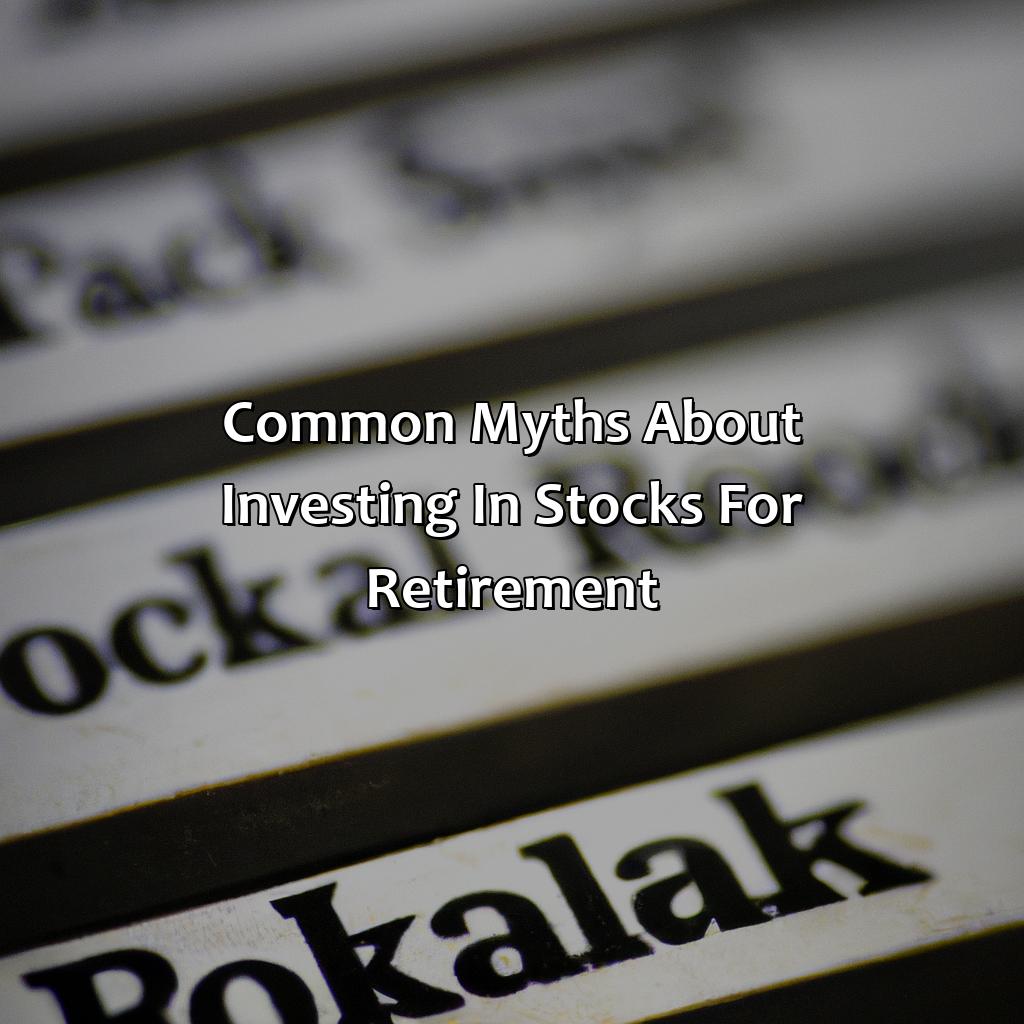
Image credits: retiregenz.com by Joel Duncun
Stocks are too risky for retirement
It is a common myth that stocks are too risky for retirement. However, investing a portion of your retirement portfolio in stocks can help grow your wealth, providing you have a long-term investment horizon. Stocks have yielded higher returns compared to bonds or cash over the long term. As an investor, it’s essential to consider your risk tolerance and diversify your portfolio across various assets.
Studies show that most people tend to live well beyond their 60s or 70s, making it critical to invest in equities for long-term financial stability and growth. In contrast, conservative investments like bonds may not deliver the required growth needed to finance longer retirements. On the other hand, investing solely in high-risk assets may not be suitable either as retirees typically require lower volatility as they depend on their pension fund over an extended period.
Retirees who relied entirely on cash and fixed-income investments faced a severe challenge during the Covid-19 pandemic market volatility. Research suggests that investors should aim for higher equity allocations until ten years before retirement and gradually decrease their exposure towards more conservative investments. This way, they benefit from equities’ return potential and avoid any sudden drops closer to retirement.
A colleague’s 72-year-old mother invested $10k heavily in blue-chip stocks in her early 50s with diversified holdings, in spite of caution from relatives and financial advisors around her age at the time. She held these positions throughout the turbulence of multiple market fluctuations like Black Monday (1987) and the Great Recession (2008). She was able to retire early due to her investment gains and had significant capital appreciation when she needed it most.
Who needs a retirement portfolio when you can just play the lottery and hope for the best? Oh wait, that only works for people who like to live dangerously.
Older investors should avoid stocks
Investing in stocks for retirement is a common myth that older investors should avoid. However, the truth is that stocks play an essential role in a balanced portfolio, especially when planning for long-term retirement goals.
Stocks have historically outperformed other asset classes over long periods, thus can provide better returns to help retirees keep up with inflation and maintain their purchasing power. Furthermore, pension funds and large institutional investors often invest heavily in stocks, indicating the importance of this asset class for long-term growth.
While stock market fluctuations can cause anxiety for some investors, long-term investing aims to minimize short-term volatility and maximize overall returns. It’s crucial to diversify investments across various sectors and industries using mutual funds or exchange-traded funds (ETFs) that deliver professional management at lower costs than actively managed mutual funds.
A Vanguard study found that over a 20-year period ending in 2018, a balanced portfolio comprising 60% stocks and 40% bonds had an annualized return of more than 7%. This proves how important it is for retirees to consider investing in stocks as part of their retirement plan.
Who needs simplicity when you can have the thrill of potential financial ruin?
Investing in stocks is too complicated
Investing in stocks may seem overwhelming, but with the right guidance and knowledge, it can be manageable. The perception of complexity is a common myth that deters potential investors from exploring this asset class.
In reality, investing in stocks’ basics are fairly straightforward. Before jumping into the stock market, investors should understand fundamental analysis techniques, like researching a company’s financial statements and market trends. Additionally, investors should conduct risk assessments to determine their investment objectives and evaluate their tolerance for risk.
It’s important to remember that diversification is key when investing in stocks as the stock market can fluctuate dramatically. To minimize risks, investors should spread their investments across different sectors and companies.
A fundamental part of retirement planning includes adding stocks to one’s portfolio. A diversified combination of stocks, bonds, real estate assets, and other investments can help provide growth opportunities while protecting against volatility.
Overall, investing in stocks requires research and attention to detail yet you don’t need to have an advanced degree or a vast amount of wealth to do so. With careful planning and discipline over time with a professional financial advisor individuals can achieve their retirement goals through stock investing.
Importance of monitoring and adjusting your stock portfolio for retirement
The Significance of Adjusting and Monitoring your Stock Investment for Retirement
Maintaining and modifying stock investments is crucial for retirement. Regularly assessing your investment portfolio allows you to make strategic decisions for better financial growth while minimizing risks. Keeping track of capital gains and market trends, analyzing fee structures, diversifying investments, and periodically adjusting investments to changing market conditions are important steps in monitoring your stock investments.
Diversification and balancing your portfolio with varying types of investments are critical for long-term sustainability of your savings and reducing risks. Continuously monitoring the state of your investments and adjusting them accordingly will help you earn more and avoid losing wealth.
Understand the significance of making timely adjustments and diversification in your investment portfolio for retirement. Proper management of your stock investments and monitoring is pivotal to secure your financial future and growth.
Don’t let the fear of missing out (FOMO) on earning the maximum return on your investment diminish your financial wellness. Start adapting and monitoring your stock investments; modify where necessary to create a balanced and sustainable retirement portfolio.

Image credits: retiregenz.com by Harry Jones
Five Facts About Why Stocks Belong in a Retirement Portfolio:
- ✅ Stocks have historically provided high long-term returns, outpacing inflation and other investments. (Source: CNBC)
- ✅ Diversifying retirement portfolios with stocks can help mitigate risk and enhance returns. (Source: Investopedia)
- ✅ Many retirement savings plans, such as 401(k)s and IRAs, offer stock investment options. (Source: NerdWallet)
- ✅ Investing in dividend-paying stocks can provide a source of retirement income. (Source: US News & World Report)
- ✅ Stocks offer the potential for growth and can help retirees keep up with rising expenses over time. (Source: Forbes)
FAQs about Why Stocks Belong In A Retirement Portfolio?
1. Why should I include stocks in my retirement portfolio?
Stocks have historically outperformed other asset classes in the long term, providing higher returns and better inflation protection. Investing in stocks can also reduce the risk of running out of money in retirement as they have the potential to generate higher returns over a longer period of time.
2. What kind of stocks should I invest in for my retirement portfolio?
When investing in stocks for your retirement portfolio, consider diversifying across a range of industries, sectors, and company sizes to spread out risks. Investing in index funds or exchange-traded funds (ETFs) that track the overall stock market can be a good option for beginners.
3. Are stocks too risky for a retirement portfolio?
While stocks can be volatile in the short term, investing in them over the long term has historically provided higher returns and can be a way to combat inflation and ensure a retirement nest egg lasts. It’s important to strike a balance and not over-invest in stocks, especially as you get closer to retirement.
4. How can I manage the risk of investing in stocks for retirement?
Diversification is key to managing the risk of investing in stocks for retirement. It’s a good idea to spread your investment across stocks of various sizes, industries, and sectors, as well as to consider investing in bonds or other asset classes that are less volatile. Regularly reviewing and adjusting your portfolio can also help manage risk.
5. Is it ever too late to start investing in stocks for retirement?
No, it’s never too late to start investing in stocks for retirement. While starting early is the best way to maximize the power of compound interest, even those who are close to retirement can benefit from including stocks in their portfolio. The key is to have a plan and to start investing as soon as possible.
6. How much of my retirement portfolio should be allocated to stocks?
The right allocation for your retirement portfolio will depend on a number of factors, including your age, risk tolerance, and overall financial goals. As a general rule, younger investors with a longer time horizon may want to allocate a higher percentage of their portfolio to stocks compared to those who are closer to retirement. Consulting with a financial advisor can help you determine the appropriate allocation for your retirement portfolio.




